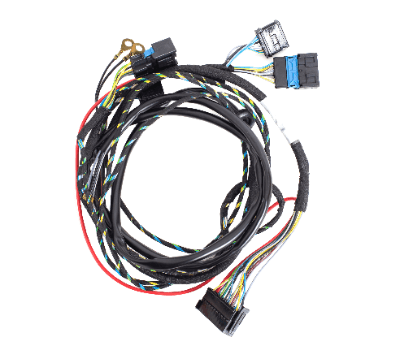What Is a Cable Harness?
 A cable harness is a bundle of multiple wires used for power supply and signal communication, with connectors attached to the ends.
A cable harness is a bundle of multiple wires used for power supply and signal communication, with connectors attached to the ends.
A cable is a multi-core wire. The main use of cables is to transfer information between electronic devices in factory automation, automotive, and other applications.
In some cases, the company prepares its cables for its products, while in other cases, the company makes its cables by making its arrangements through websites where general-purpose parts are available. Because of the wide variety of products and the fact that they are not suitable for automated production, most are produced manually.
Uses of Cable Harnesses
Cable harnesses are used for communication between electronic devices in factory automation (FA), connected autonomous vehicles (xEV), and connected autonomous shared service electrics (CASE).
In the field of consumer electronics, it is used to exchange electrical signals and supply power to home appliances such as air conditioners, refrigerators, and microwave ovens. Harnesses used in audio-visual equipment such as TVs and music players, and office equipment such as PCs and copy machines are often simpler and shorter in structure than those used in automobiles.
In medical equipment, cable harnesses are used in small to medium-sized devices such as blood pressure monitors, electrocardiographs, and angiography equipment, as well as in large devices such as MRI, CT, X-ray equipment, and ultrasound diagnostic equipment. Cable harnesses from many industries are used in production facilities that manufacture automobiles and medical equipment. They are also used to control robots introduced in factory automation.
Principle of Cable Harnesses
Cable harnesses serve to transmit electric power to power various devices and electrical signals for device control, and are incorporated into automobiles and various machinery and equipment.
There are many communication methods used in industrial applications, with CAN, Ethernet, and CC-LINK communications being the most common. In consumer applications, dedicated connectors and USB connectors are used for cables for data transmission and network communication to exchange data, such as audio, video, and data files.
Cables used in cable harnesses consist of multiple wires covered with a sheath. The sheath is used as a protective material for the wires. Especially for wiring to moving control equipment, flexible cables with excellent bending resistance are used only for the moving parts to prevent premature wire breakage.
Other Information on Cable Harnesses
1. Advantages of Cable Harnesses
When wiring becomes complicated, cables may interfere with other wires or parts or may be worn out due to shaking or vibration. Therefore, harnessing cables together protects them.
Another advantage is that some cables can have environmental resistance to fire, oil, noise, etc. as a function. Furthermore, there are other advantages, such as simplified installation and prevention of mistakes through simplification by having the cables grouped.
2. The Future of Cable Harnesses
The cable harness has evolved, especially in automobiles. As more functions are added to automobiles, cable harnesses are being used to connect each device and component, and the number of harnesses is on the rise. Some harnesses have more than 2,000 cables per car, and the total length is said to be as long as 1,000 to 1,300 feet.
In the future, there are many issues to be tackled, such as changes in materials and weight reduction. Not only copper, which has been the mainstream material for cable harnesses in the past but also aluminum is becoming increasingly popular. Furthermore, the demand for cable harnesses is increasing together with the growing demand for electric and hybrid vehicles.
At the same time, changes in consumer behavior are occurring, and the needs for automobile functions are expected to diversify. Cable harnesses are also an important automotive component and must change with these changes in demand and the evolution of technology.